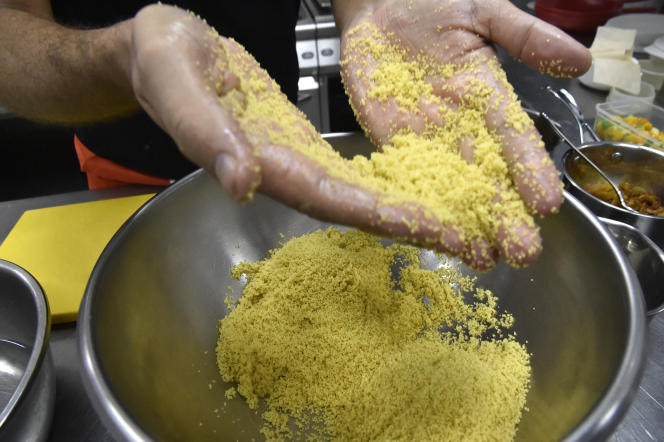Couscous, Mohamed Baya likes it pink, colored with beets. With vegetables in brunoise, pumpkin in mousseline and turnips in tiles, to vary the textures. With scallops or sea bream, washed down with a crayfish bisque. But whatever his way of revisiting this emblematic Maghreb dish, the Moroccan chef never omits a hint of cinnamon. This sweet flavor is her “Madeleine of Proust”.
At the stove of La Table clandestine (a table d’hôtes concept he launched in 2017 in Casablanca, in the heart of the old city center with its Art Deco buildings), the 40-year-old chef remembers the day he cooked couscous for the first time. “It was in Paris, where I made my debut, he says. I was second in a restaurant near Les Halles. We had sprinkled the juice with ras el-hanout, and in this mixture of spices I smelled cinnamon, almost imperceptible if you don’t know it’s there. Suddenly, I went back years! It was the missing flavor of my mother’s couscous. »
A dish that takes you back in time, couscous is also one of those that brings people together. “There is nothing more social than couscous” in the eyes of this enthusiast, known to Moroccans for having been a member of the jury of the “MasterChef” television competition and, this year, of the national selection for the Bocuse d’or Africa. Friday, day of prayer, “you will always see large plates wandering from house to house”, he said: “Because couscous is necessarily prepared in large quantities to be shared. It is the dish of religious festivals and family reunions par excellence. »
Rare moment of North African union
He is a symbol of ” live together “, had recognized Unesco, in December 2020, by including couscous and its traditions on the list of intangible cultural heritage. In a rare moment of North African unity, the application file had been brought jointly by Algeria, Morocco, Mauritania and Tunisia, which had long disputed the paternity of this dish. So much so that this inscription had been hailed both as the recognition of what these four North African countries have at their strongest in their culinary culture, but also as an ingredient of rapprochement between Algeria and Morocco, whose relations are undermined by the Western Sahara file.
A culinary agreement, however, questioned according to the vagaries of diplomacy. A year later, in November 2021, when the two rivals from the Maghreb had broken off their relations, the Moroccan Minister of Culture, Mohamed Mehdi Bensaid, announced that he wanted to give couscous a “Morocco label” – even if the approach had little chance of succeeding, Unesco having put an end to the debate.
In the eyes of scientists, this ancestral dish does not adapt well to borders. Just like these many cultural elements that Algeria and Morocco accuse each other of appropriating, such as raï, zellige, caftan… The origin of couscous dates back to the Middle Ages and even earlier. “Utensils similar to couscous dishes, present in the tomb of the Berber king Massinissa [vers 240-148 av. J.-C.], are evoked by the historian Lucie Bolens, while a fragment of couscoussier of the IXe century was discovered near Tiaret”, in Algeria, reports the Algerian expert Ouiza Gallèze, who coordinated the UNESCO dossier alongside counterparts from the three other countries. ” At that time, she specifies to avoid any controversy, Tiaret was neither in Algeria nor in Morocco: it was the same kingdom. »
“Royal” couscous, a heresy
In a writing of the twelfthe century, couscous is mentioned by Ibn Al-Banna Al-Marrakushi, A scholar of Marrakech: “He says that when the Arabs arrived, in the VIIe century, they found couscous so good that doctors prescribed it to the sick, continues Ouiza Gallèze. In the fourteenthe century, Ibn Khaldoun, great master of thought, cites him as a reference to define the man of the Maghreb: he is the one who “wears the burnous and eat the couscous”. »
“Historically, couscous is an essential dish, as ordinary as bread and soup, consumed every day in the pre-colonial dietary habits of the Maghreb”, adds Moroccan historian Mohamed Houbaida. A dish of Berber origin that it would be wrong to reduce to a handful of variants, he underlines, as the recipes – and the names – are endless. Wheat or barley semolina, caramelized onions, seven vegetables, argan oil… “As we usually say, summarizes this specialist, there are as many couscous as there are villages! »
As for knowing which is the best of all, chef Baya immediately rules out the so-called “royal” multi-meat version, with merguez sausages and lamb chops. This French invention is a heresy in the south of the Mediterranean, where “We don’t mix the meats and we don’t cook the food separately”he points out.. In the Maghreb, “Moroccans will surely say of their couscous that it is more complex, more worked with spices, but other countries may say the same of theirs”. Besides, it is better to answer in the least controversial way, the one that generally makes everyone agree: “The best couscous is my mother’s. »
